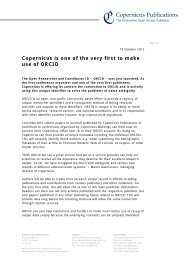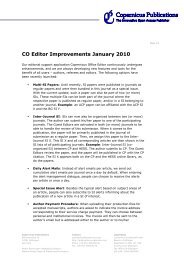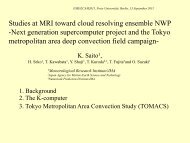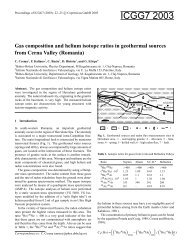Proceedings of ERAD (2004) - Copernicus.org
Proceedings of ERAD (2004) - Copernicus.org
Proceedings of ERAD (2004) - Copernicus.org
Create successful ePaper yourself
Turn your PDF publications into a flip-book with our unique Google optimized e-Paper software.
<strong>Proceedings</strong> <strong>of</strong> <strong>ERAD</strong> (<strong>2004</strong>): 109–114 c○ <strong>Copernicus</strong> GmbH <strong>2004</strong><br />
<strong>ERAD</strong> <strong>2004</strong><br />
Principles <strong>of</strong> networked weather radar operation at attenuating<br />
frequencies<br />
V. Chandrasekar 1 , S. Lim 1 , N. Bharadwaj 1 , W. Li 1 , D. McLaughlin 2 , V. N. Bringi 1 , and E. G<strong>org</strong>ucci 3<br />
1 Colorado State University, Fort Collins CO, 80523, USA<br />
2 University <strong>of</strong> Massachusetts, Amherst, MA, USA<br />
3 National Research Council <strong>of</strong> Italy, Rome, Italy<br />
1 Introduction<br />
Conventional meteorological radars provide coverage for<br />
long ranges (<strong>of</strong>ten hundreds <strong>of</strong> kilometers) and support<br />
weather surveillance and hydrological monitoring applications<br />
by using high power transmitters and mechanically<br />
scanned antennas. These systems operate at wavelengths in<br />
5–10 cm range in order to minimize attenuation due to precipitation,<br />
and this necessitates the use <strong>of</strong> physically large antennas<br />
to achieve good resolution at distant ranges. Research<br />
radars with observations at short ranges have demonstrated<br />
great potential for “targeted applications” such as tornado<br />
detection and flash flood monitoring. Therefore it would be<br />
desirable to develop radar systems for targeted applications.<br />
The usefulness <strong>of</strong> radar to a specific application is heavily<br />
dependent on the accuracy and resolution <strong>of</strong> coverage. A fundamental<br />
physical limit imposed by transmission from single<br />
radar is the problem <strong>of</strong> changing resolution as a function <strong>of</strong><br />
range. In addition the lowest coverage altitude gets higher<br />
with range due to earth curvature. As an alternate solution,<br />
a networked radar environment concept has been proposed<br />
(Chandrasekar and Jayasumana, 2001; McLaughlin, 2001).<br />
The basic principle <strong>of</strong> the networked radar environment is to<br />
be able to provide good coverage, in terms <strong>of</strong> accuracy and<br />
resolution to a large area through a network <strong>of</strong> radars. In order<br />
to be able to provide “economically feasible” solution to<br />
this approach, meteorological radar operation must change<br />
from the “preferred” S band operation to higher frequencies<br />
(just as space borne weather radar systems). However there<br />
are new sets <strong>of</strong> problems at higher frequencies, the major one<br />
being the impact <strong>of</strong> attenuation due to precipitation. In addition<br />
the requirement for combining observation from multiple<br />
radars also provides additional sets <strong>of</strong> challenges.<br />
The U.S National Science Foundation recently established<br />
an Engineering Research Center titled the Center for Collaborative<br />
Adaptive Sensing <strong>of</strong> the Atmosphere (CASA),<br />
Correspondence to: V. Chandrasekar<br />
(chandra@engr.colostate.edu)<br />
formed by a consortium <strong>of</strong> four universities namely (listed alphabetically),<br />
Colorado State university, University <strong>of</strong> Massachusetts<br />
(lead University), University <strong>of</strong> Oklahoma, and<br />
University <strong>of</strong> Puerto Rico and partnership with industry and<br />
government labs to create the underlying science and engineering<br />
basis for new paradigm <strong>of</strong> networked radars applied<br />
to hazardous localized weather detection, tracking, and predicting.<br />
This paper describes the governing physical principles for<br />
operating a networked radar system at attenuating frequencies.<br />
Models <strong>of</strong> backscatter and forward scatter <strong>of</strong> precipitation<br />
volumes are studied to enable retrievals <strong>of</strong> intrinsic<br />
reflectivity and velocity. High-resolution observations from<br />
the CSU-CHILL radar are used to evaluate the impact <strong>of</strong><br />
space/time variation <strong>of</strong> precipitation in a networked radar environment.<br />
Preliminary results <strong>of</strong> the analysis conducted at<br />
X band frequencies are presented.<br />
2 Attenuation statistics for radar design at X-Band<br />
Attenuation due to precipitation is perhaps one <strong>of</strong> the most<br />
important factors to be dealt with while developing radars<br />
at high frequencies such as X-band. X-band radars suffer<br />
electromagnetic wave attenuation due to rain. For X-band<br />
radar design it is important to characterize the possible attenuation<br />
for a given maximum range <strong>of</strong> operation. The only<br />
way to collect such data is from dual frequency radar system<br />
with matched beams, one at non-attenuating frequency<br />
and the other at attenuating frequency. This paper presents<br />
an indirect approach to build such statistics. Chandrasekar<br />
et al. (2002) discuss simultaneous observations <strong>of</strong> rain by<br />
dual polarization radars at S- and X-band. Chandrasekar et<br />
al. (1990) showed that specific attenuation (kX h ) at X-band<br />
) at S<br />
can be predicted from specific differential phase (K S dp<br />
band. The relations between K S dp and kX h<br />
k X h (r) ∼ = ahK S dp<br />
can be written:<br />
(1)
110 V. Chandrasekar et al.: Principles <strong>of</strong> networked weather radar operation<br />
Figure 2. Attenuation margin at X band frequency. Curves are obtained using data collected<br />
Fig. 2. Attenuation margin at X band frequency. Curves are ob-<br />
Figure Fig. 1. Relationship 1. Relationship between between specific specific attenuation attenuation at X band and at Xspecific band differential from<br />
and tained phase various using radar data ranges, collected i.e. 30km from to various 90km. Attenuation radar ranges, statistics i.e. computed 30 km t<strong>of</strong>rom<br />
differential phase observed by CSU-CHILL radar.<br />
at S specific band for widely differential varying phase DSD. at S band for widely varying DSD. 90 km. Attenuation statistics computed from differential phase observed<br />
by CSU-CHILL radar.<br />
where kX h is specific attenuation at X-band in horizontal polarization<br />
and KS dp is specific differential phase at S-band<br />
(φdp).<br />
Figure 1 shows a scatter plot <strong>of</strong> kX h versus KS dp for widely<br />
varying raindrop size distribution. Based on the result shown<br />
in Fig.1, the cumulative attenuation at X-band AX h can be<br />
related to the differential propagation phase at S band as<br />
A X = 2<br />
R<br />
k<br />
0<br />
X h<br />
(r)dr ≈ 2<br />
R<br />
0<br />
aK S dp (r)dr = aS dp<br />
Two months <strong>of</strong> data collected by the CSU-CHILL radar (Sband)<br />
during the STEPS campaign (Severe Thunderstorm<br />
Electrification and Precipitation Study; conducted along the<br />
Colorado/Kansas border, May 26 ∼Jul 19, 2000) collected<br />
by CSU-CHILL radar (S-band) were used in the estimation<br />
<strong>of</strong> the attenuation at X-band. For a given range, the cumulative<br />
density function <strong>of</strong> attenuation was calculated to compute<br />
the attenuation exceedence curves. Figure 2 shows the<br />
two-way attenuation statistics for the geographical region under<br />
study. Such statistics are useful in developing attenuation<br />
margin for X-band frequency. It can be seen that if the radar<br />
range is 30 km, 10% <strong>of</strong> precipitation cells will cause the attenuation<br />
beyond 19 dB.<br />
3 Ground clutter<br />
Radars designed for targeted applications at short ranges mitigate<br />
the earth curvature problem and provide finer resolution<br />
with smaller antennas compared to their S-band counterparts.<br />
Figure 3 (adopted from NRC 1995) shows the typical “lack<br />
<strong>of</strong>” low altitude coverage at far ranges. However radar observations<br />
at short ranges are contaminated by ground clutter.<br />
Ground clutter at close range could come from side lobes <strong>of</strong><br />
the antenna or main lobe, depending on the radar altitude<br />
(2)<br />
or the phenomena being observed. Specifically designing<br />
radars for short-range operation needs extensive emphasis<br />
for clutter mitigation. At close ranges the equivalent radar<br />
reflectivity due to clutter can easily be in the 40 to 60 dBZ<br />
range, whereas the phenomena being observed such as light<br />
rain or tornado may have echoes in the range <strong>of</strong> 20 to 40 dBZ.<br />
Therefore extreme care is needed for clutter mitigation.<br />
4 Range-velocity ambiguity<br />
Doppler weather radars transmitting pulses with uniform<br />
9<br />
pulse repetition frequency (PRF) have a fundamental limitation<br />
on maximum unambiguous range (rmax) and maximum<br />
unambiguous velocity (vmax) given by<br />
rmaxvmax = cλ<br />
. (3)<br />
8<br />
In Eq. (3) λ is radar wavelength and c is the velocity <strong>of</strong> light.<br />
Moving to higher frequencies such as X-band brings down<br />
the rmaxvmax by a factor three compared to S-band. For example<br />
if rmax is kept at 150 km with a 1 millisecond pulse<br />
repetition time, the vmax at X-band drops to ±7.5 m/s. There<br />
is always a trade <strong>of</strong>f between rmax and vmax (Range-velocity<br />
ambiguity). Precipitation echoes can be distributed over a<br />
large area and the dynamic range <strong>of</strong> the radar reflectivity can<br />
be as high as 65 dB resulting in range overlay. Velocity measurements<br />
can span ±100 m/s in severe storms resulting in<br />
velocity folding. Figure 4 shows the range-velocity limitation<br />
<strong>of</strong> an X-band radar compared to S-band radar.<br />
X-band radars have a low unambiguous velocity due to<br />
their short wavelength, and increasing the PRF to mitigate<br />
this problem will result in multiple trip overlays as storms<br />
can extend over a large distance. It can be observed that<br />
10
V. Chandrasekar et al.: Principles <strong>of</strong> networked weather radar operation 111<br />
Fig. 3. The typical “lack Figure <strong>of</strong>” low 3. The altitude typical coverage “lack at<strong>of</strong>” farlow ranges altitude (adopted coverage from NRC at far 1995). ranges (adopted from NRC 1995).<br />
Maximum Unambiguous Velocity (m/s)<br />
150<br />
125<br />
100<br />
75<br />
50<br />
25<br />
Range<br />
S-band<br />
X-band<br />
0<br />
0 0.5 1 1.5 2 2.5 3 3.5 4 4.5 5 0<br />
PRF (kHz)<br />
Figure 4. Comparisons <strong>of</strong> range-velocity limitations for S-band and X-band radars.<br />
Fig. 4. Comparisons <strong>of</strong> range-velocity limitations for S-band and Figure Fig. 5. Concept 5. Concept <strong>of</strong> networked <strong>of</strong> networked radar environment. radar environment.<br />
X-band radars.<br />
range-velocity ambiguity is much more severe for X-band<br />
radars compared to the conventional S band.<br />
Several range-velocity ambiguity mitigation schemes have<br />
been proposed. Staggered pulsing can be used to increase the<br />
unambiguous velocity whereas phase coding <strong>of</strong> the transmitted<br />
pulse can be used to mitigate range overlay (Zrnic and<br />
Mahapatra, 1985). Implementing these techniques for good<br />
performance at X-band is challenging and several solutions<br />
are being evaluated (Bharadwaj et al., <strong>2004</strong>). All the above<br />
methods have been tested with S-band and C-band radars.<br />
Application to X-band is being evaluated.<br />
150<br />
125<br />
100<br />
75<br />
50<br />
25<br />
Maximum Unambguous Range (km)<br />
5 Networked radar environment<br />
Figure 5 shows the intrinsic reflectivity at X-band<br />
11<br />
that was<br />
simulated from S-band observations. Figure 5 also shows a<br />
network <strong>of</strong> six radars A, B, C, D, E and F observing the same<br />
storm cell. Using a fairly accurate methodology to simulate<br />
X-band observations (Chandrasekar et al., <strong>2004</strong>), Figs. 6a<br />
and b show the observations <strong>of</strong> the same storm by X-band<br />
radars located at A and C. The observed reflectivity by radars<br />
A and C is different than the intrinsic reflectivity shown in<br />
Fig. 5 because <strong>of</strong> path attenuation, which is dependent on the
112 V. Chandrasekar et al.: Principles <strong>of</strong> networked weather radar operation<br />
(a)<br />
(b)<br />
Figure Fig. 6. 6. Measured reflectivity reflectivity by radar byA radar (a) and A C (a) (b). and C (b).<br />
location <strong>of</strong> the radar, storm and the rain path. The intrinsic<br />
radar reflectivity can be retrieved from these observations using<br />
a variety <strong>of</strong> methods and two which are discussed in the<br />
following section.<br />
5.1 Attenuation correction using dual-polarization radar<br />
measurements<br />
Differential phase measurements have been shown to be very<br />
useful for correcting the measured reflectivity for precipitation<br />
induced attenuation. This section describes two attenuation<br />
correction methodologies with specific emphasis on Xband.<br />
Simple differential phase based algorithm (DP) as well<br />
as the range-pr<strong>of</strong>iling algorithm based on differential phase<br />
constraints (DPC) were compared. Both <strong>of</strong> the algorithms for<br />
attenuation correction work fairly well (Bringi et al., 1990;<br />
Testud et al., 2000). Attenuation correction is required for<br />
any applications <strong>of</strong> radar data, such as feature detection algorithms,<br />
or rainfall estimation. Attenuation correction using<br />
reflectivity measurements alone, done iteratively from ranges<br />
Figure 7. Normalized Standard Error (left axis) and Normalized Bias (right axis) <strong>of</strong><br />
Fig. 7. Normalized Standard Error (left axis) and Normalized Bias<br />
cumulative attenuation, relative to X-band pr<strong>of</strong>iles based on S-band observations, as a<br />
(right axis) <strong>of</strong> cumulative attenuation, relative to X-band pr<strong>of</strong>iles<br />
function <strong>of</strong> range. The estimation <strong>of</strong> attenuation has been obtained using DPC and DP<br />
based on S-band observations, as a function <strong>of</strong> range. The estima-<br />
algorithms in presence <strong>of</strong> measurement errors.<br />
tion <strong>of</strong> attenuation has been obtained using DPC and DP algorithms<br />
in presence <strong>of</strong> measurement errors.<br />
close to the radars, were very unstable. Coherent polarization<br />
diversity radars brought significant advancements for attenuation<br />
correction in rain through the use <strong>of</strong> differential propagation<br />
phase. This ability has accelerated the consideration<br />
<strong>of</strong> X-band radars for rainfall monitoring.<br />
The differential phase attenuation correction procedure<br />
(DP) is fairly simple to implement. The DPC method is not<br />
as simple, nevertheless easy to implement in modern pro-<br />
cessors. Regarding the correction <strong>of</strong> cumulative attenuation,<br />
14<br />
both algorithms provide similar performance, with the differential<br />
phase constraint technique performing slightly better.<br />
Extensive study on these algorithms has been performed, and<br />
only summary <strong>of</strong> the results are provided for brevity. Both algorithms<br />
could keep the corrected reflectivity within ±1 dB<br />
for 85% <strong>of</strong> the time, for the intense rain cells studied (Chandrasekar<br />
et al., <strong>2004</strong>). In absence <strong>of</strong> measurement errors DP<br />
algorithm can provide much better estimates <strong>of</strong> the specific<br />
attenuation estimates compared to DPC method. However,<br />
practical issues associated with slope estimation reduce the<br />
resolution <strong>of</strong> the specific attenuation estimates, and suppress<br />
peaks. Figure 7 shows the normalized standard error (NSE)<br />
and bias <strong>of</strong> cumulative attenuation estimates for an 18 km<br />
rain path over intense precipitation. The NSE is defined as<br />
standard deviation normalized with respect to the mean. At<br />
short ranges the “absolute attenuation” is fairly small and the<br />
NSE is high due to that. For intense rain paths less than<br />
10 km 95 % <strong>of</strong> the attenuation, corrected reflectivity stayed<br />
within ±1 dB <strong>of</strong> the intrinsic value, demonstrating the ability<br />
<strong>of</strong> the differential phase based attenuation correction as well<br />
as DPC correction.<br />
15
V. Chandrasekar et al.: Principles <strong>of</strong> networked weather radar operation 113<br />
Figure 8. Schematic showing the conceptual arrangement for reflectivity retrieval with<br />
Fig. 8. Schematic showing the conceptual arrangement for reflectivity<br />
networked retrieval radars. with networked radars.<br />
5.2 Reflectivity retrieval in the networked radar environment<br />
An alternate approach for to attenuation correction can directly<br />
use the networked radar approach. The specific attenuation<br />
distribution can be obtained from the integral equation<br />
for reflectivity, in a manner similar to that used with a differential<br />
phase constraint. The set <strong>of</strong> governing integral equations<br />
describing the backscatter and propagation properties<br />
<strong>of</strong> a common resolution volume are solved simultaneously<br />
with constraints on observed total path attenuation.<br />
A three-radar network system is used for illustration as<br />
shown in Fig. 8. The retrieved reflectivity (Zc(r)) can be<br />
expressed in terms <strong>of</strong> the measured reflectivity (Zm(r)) and<br />
specific attenuation (kh) at range r as<br />
r<br />
Zc(r) = Zm(r) + 2 kh(s)ds (4)<br />
r0<br />
If we know the intrinsic reflectivity (Ze(rm)) at range rm, the<br />
specific attenuation along the path can be described as<br />
Z(rm) = Ze(rm) − Zm(rm); (5)<br />
kh(r) =<br />
[Zm(r)] b (100.1bZ(rm) − 1)<br />
I (r0; rm) + (100.1bZ(rm) ; (6)<br />
− 1)I (r; rm)<br />
rm<br />
I (r0; rm) = 0.46b [Zm(s)] b ds (7)<br />
r0<br />
where Z(rm) is the difference between intrinsic reflectivity<br />
and attenuated reflectivity, namely two-way cumulative attenuation,<br />
and parameter b corresponds to k − Z relation. A<br />
Fig.<br />
Figure<br />
9. (a)<br />
9. (a)<br />
Intrinsic<br />
Intrinsic<br />
reflectivity<br />
reflectivity<br />
and<br />
and<br />
(b)<br />
(b)<br />
retrieved<br />
retrieved<br />
reflectivity.<br />
reflectivity<br />
networked based solution is developed to solve for the intrinsic<br />
reflectivity and attenuation (Lim et al., <strong>2004</strong>).<br />
The optimum retrieved reflectivity at point O in Fig. 8 can<br />
be obtained by16 networked radar approach. Figure 9 shows<br />
the intrinsic reflectivity and retrieved reflectivity for common<br />
region by each radar, where as Fig. 10 shows the scatter plot<br />
<strong>of</strong> intrinsic reflectivity versus retrieved reflectivity. The standard<br />
deviation <strong>of</strong> the difference between intrinsic reflectivity<br />
and retrieved reflectivity is 0.62 dBZ, showing good performance.<br />
6 Conclusions<br />
Center for Collaborative Adaptive Sensing <strong>of</strong> the Atmosphere<br />
(CASA) is a consortium <strong>of</strong> universities, industry<br />
and government labs, established recently to develop the<br />
paradigm <strong>of</strong> networked radar environment, operating collaboratively<br />
adapting to the needs <strong>of</strong> the end users, as well as the<br />
(a)<br />
(b)
114 V. Chandrasekar et al.: Principles <strong>of</strong> networked weather radar operation<br />
prevailing environment. The preliminary results shown here<br />
demonstrate that a distributed network approach, operating<br />
collaboratively adapting to the prevailing characteristics <strong>of</strong><br />
precipitation can provide reasonable solutions to challenging<br />
problems such as retrieval <strong>of</strong> intrinsic reflectivity. Similar solutions<br />
are being pursued to resolve other challenges such as<br />
multi-dimensional Doppler retrieval and clutter mitigation,<br />
in order to enable operations at higher frequencies. Several<br />
generations <strong>of</strong> test beds will be developed with the initial one<br />
being a network <strong>of</strong> X-band radars with mechanically scanned<br />
antennas and the subsequent ones will include advances such<br />
as electronic scanning.<br />
Acknowledgement. This research was supported by the National<br />
Science Foundation, Engineering Research Center Program (ERC-<br />
0313747). The authors acknowledge, the stimulating discussions<br />
with the large number <strong>of</strong> participants in CASA.<br />
References<br />
Bharadwaj, N., Chandrasekar, V., and Hubbert, J. C.: Staggered<br />
hybrid pulsing for polarimetric weather radars at X-band, <strong>Proceedings</strong><br />
<strong>of</strong> IGARSS04, <strong>2004</strong>.<br />
Bringi, V. N., Chandrasekar, V., Balakrishnan, N., and Zrnic, D. S.:<br />
An examination <strong>of</strong> propagation effects in rainfall on radar measurements<br />
at microwave frequencies, J. Atmos. Oceanic Technol.,<br />
7, 829–840, 1990.<br />
Chandrasekar, V., Bringi, V. N., Balakrishnan, N., and Zrnic, D. S.:<br />
Error Structure <strong>of</strong> Multiparameter Radar and Surface Measurements<br />
<strong>of</strong> Rainfall, Part III: Specific Differential Phase, J. Atmos.<br />
Oceanic Technol., 7, 621–629, 1990.<br />
Chandrasekar, V. and Jayasumana, A. P.: Radar Design and Management<br />
in a Networked Environment, <strong>Proceedings</strong>, ITCOMM,<br />
Denver CO, 142–147, 2001.<br />
Chandrasekar, V., G<strong>org</strong>ucci, E., and Baldini, L.: Evaluation <strong>of</strong> polarimetric<br />
radar rainfall algorithms at X-band., <strong>ERAD</strong>02, 277–<br />
281, 2002.<br />
Chandrasekar, V., G<strong>org</strong>ucci, E., Lim, S., and Baldini, L.: Simulation<br />
<strong>of</strong> X-Band Radar Observation <strong>of</strong> Precipitation from S-Band<br />
Measurements, <strong>Proceedings</strong> <strong>of</strong> IGARSS04, <strong>2004</strong>.<br />
Lim, S., Chandrasekar, V., and McLaughlin, D.: Retrieval <strong>of</strong><br />
reflectivity in a networked radar environment, <strong>Proceedings</strong> <strong>of</strong><br />
IGARSS04, <strong>2004</strong>.<br />
McLaughlin, D.: Presentation to “Weather Radar Technology Beyond<br />
Nexrad”, National Research Council, National Academy<br />
Press, Washington, D.C., 2001.<br />
NRC: Assessment <strong>of</strong> NEXRAD Coverage and Associated Weather<br />
Services, Washington, D.C., National Academy Press, 1995.<br />
Testud, J., Bouar, E. L., Obligis, E., and Ali-Mehenni, M.: The<br />
rain pr<strong>of</strong>iling algorithm applied to polarimetric weather radar, J.<br />
Atmos. Oceanic Technol., 17, 322–356, 2000.<br />
Zrnic, D. S. and Mahapatra, P. R.: Two methods <strong>of</strong> ambiguity resolution<br />
in pulsed Doppler weather radars, IEEE Trans. Aerospace<br />
and Electronic Systems., AES-21, 470–483, 1985.










